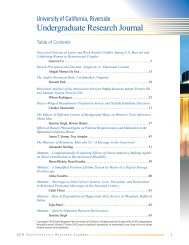UC Riverside Undergraduate Research Journal
UC Riverside Undergraduate Research Journal
UC Riverside Undergraduate Research Journal
You also want an ePaper? Increase the reach of your titles
YUMPU automatically turns print PDFs into web optimized ePapers that Google loves.
Phosphorylation of Crk Adaptor Protein by Cdc42-Activated Pak2 and Identification of Phosphorylation Sites<br />
Jisun Lee<br />
Figure 6. Sequence of the Crk. SH2 and SH3 domains, and candidate phosphorylation sites are indicated.<br />
Discussion<br />
CrkII was phosphorylated by Pak2 that was activated<br />
by the binding of Cdc42 followed by autophosphorylation. The<br />
phosphorylation and scintillation counting of 32 P showed Crk as<br />
an efficient substrate for Cdc42-activated Pak2, with 0.6 pmol/<br />
pmol of 32 P incorporation into Crk after 80 min of reaction<br />
time. To determine the sites of phosphorylation on Crk, the<br />
peptides corresponding with the spots on the 2-D maps were<br />
compared regarding their positions in the sequence of Crk. In<br />
Fig. 6, the sequences underlined with black lines indicate Glu-C<br />
digested peptides and the sequences underlined with green lines<br />
indicate trypsin digested peptides. The peptides in the boxes are<br />
candidate phosphorylation sites determined by the (K/R)RXS<br />
sequence containing the determinants for potential substrates<br />
phosphorylated by Pak2. Due to the fact that the spots in each<br />
of the phosphopeptide maps were close to each other, exact<br />
numbers of the sites of phosphorylation cannot be identified.<br />
Glu-C cleaved at glutamic acid, and trypsin cleaved at lysine<br />
and arginine. According to similar sizes of phosphopeptides<br />
cleaved in both 2-D maps, and the (K/R)RXS phosphorylation<br />
sequence, the underlined sequences are only sequences that<br />
contain similar sizes and charges for each phosphopeptide. Thus<br />
identification of phosphorylation sites via mass spectrometry<br />
would be essential for further study on Crk.<br />
Materials and Methods<br />
Expression and Purification of Proteins<br />
Crk and Cdc42 were transformed in Escherichia<br />
coli individually and Pak2 was expressed in TN5B-4 insect<br />
cells. The proteins were purified by glutathione affinity<br />
with glutathione-Sepharose 4B beads. GST was the tag<br />
used to purify these proteins. GST-Pak2, GST-Cdc42, and<br />
GST-Crk were removed from the glutathione beads in 10<br />
mM reduced glutathione in 50 mM Tris-HCl (pH 8.0). Each<br />
protein and three different concentrations of bovine serum<br />
albumin (BSA) were subjected to SDS-Polyacrylamide<br />
gel electrophoresis (PAGE). The gel was stained and the<br />
densities of stained protein bands were quantified via<br />
ImageJ for their concentrations.<br />
Phosphorylation assay<br />
Phosphoryation of Crk with Pak2 was carried out in a<br />
total volume of 26 ul and incubated at 30°C for 1 min to 100<br />
min. Crk (1 µg) was phosphorylated by Pak2 (0.1 µg) that<br />
was activated by Cdc42 (1 µg) and autophosphorylated in a<br />
mixture of 50 mM Tris-HCl (pH 7.4), 50 mM NaCl, and 0.18<br />
mM GTP_S. The reaction was radiolabeled with (γ- 32 P)ATP<br />
(500 cpm/pmol) in a volume of 26 ul containing 20 mM Tris-<br />
HCl (pH 7.4), 10 mM MgCl 2<br />
, 30 mM 2-mercaptoethanol,<br />
and 0.2 mM ATP. Each reaction was terminated by adding<br />
26 <strong>UC</strong>R Un d e r g r a d u a t e Re s e a r c h Jo u r n a l














